I find it’s easy sometimes to get caught up in the big, spectacular changes of Fall- changing leaves, colder temps, shorter days, and miss some of the more mundane changes. But some of those mundane changes are equally interesting in their own way. One example is the changing chirp patterns of field crickets, which we talked about last month. (Side note: in the last week, the crickets at our house have gone entirely silent. The nights are now dark , long and almost eerily quiet…) Another is stuff on the trail.
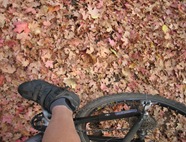 You don’t think about it much, but when you’re mtn biking or hiking during the summer, the trails generally stay pretty clean. There may be an occasional branch or twig that falls on the trail, but most of the time there’s just the same dirt and rock that was there when you rode it last week. In the Fall, all of that changes. Every time you go out on the trail, there’s some new stuff lying on the ground. In many places, especially the lower reaches of Pinebrook, it’s Maple Leaves. The Maples are about 90% bare now, with leaves forming a thick carpet in many places. (The lobes are sized just right to lodge in between a mtn bike tire and a V-brake, creating an annoying card-in-the-spokes noise.) In other areas the leaves are absent, but fallen, wind-blown samaras are present, having had the lousy luck to land in a spot they can never hop to thrive in. In a few places, underneath stands of Mountain Mahogany, you’ll find a furry carpet of feathery plumes- the tails of the fallen, wind-blown achenes.
You don’t think about it much, but when you’re mtn biking or hiking during the summer, the trails generally stay pretty clean. There may be an occasional branch or twig that falls on the trail, but most of the time there’s just the same dirt and rock that was there when you rode it last week. In the Fall, all of that changes. Every time you go out on the trail, there’s some new stuff lying on the ground. In many places, especially the lower reaches of Pinebrook, it’s Maple Leaves. The Maples are about 90% bare now, with leaves forming a thick carpet in many places. (The lobes are sized just right to lodge in between a mtn bike tire and a V-brake, creating an annoying card-in-the-spokes noise.) In other areas the leaves are absent, but fallen, wind-blown samaras are present, having had the lousy luck to land in a spot they can never hop to thrive in. In a few places, underneath stands of Mountain Mahogany, you’ll find a furry carpet of feathery plumes- the tails of the fallen, wind-blown achenes.
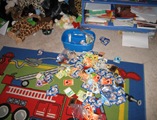 Tangent: There’s a great analogy here with the seasons of my life. In the Pre-Kids Season, 10+ years ago, the floor of our house was largely uncluttered; when I came home from work, the same stuff was or wasn’t on the floor that had or hadn’t been in the morning. But today, in the Kids Season, there’s no telling what I’ll find on the floor, most notably on the floor of Twin A’s bedroom, whose carpet is usually covered with various pile of Yugi-Oh! and Pokémon cards… 15 or so years from now, in the Post-Kids Season, I assume the floor will again be largely clutter-free, analogous to the late-Fall, post-foliage forest floor immediately before the first snow.
Tangent: There’s a great analogy here with the seasons of my life. In the Pre-Kids Season, 10+ years ago, the floor of our house was largely uncluttered; when I came home from work, the same stuff was or wasn’t on the floor that had or hadn’t been in the morning. But today, in the Kids Season, there’s no telling what I’ll find on the floor, most notably on the floor of Twin A’s bedroom, whose carpet is usually covered with various pile of Yugi-Oh! and Pokémon cards… 15 or so years from now, in the Post-Kids Season, I assume the floor will again be largely clutter-free, analogous to the late-Fall, post-foliage forest floor immediately before the first snow.
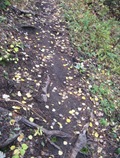 Higher up the trails are flecked with the pretty “gold coins” of Aspen leaves. But some of the most interesting things on the trails right now are pine cones, or more correctly, PLT cones. Old Douglas Fir and Engelman Spruce cones lie on or by the trails all summer long, but there are 2 obvious new things visible along trails in the fall.
Higher up the trails are flecked with the pretty “gold coins” of Aspen leaves. But some of the most interesting things on the trails right now are pine cones, or more correctly, PLT cones. Old Douglas Fir and Engelman Spruce cones lie on or by the trails all summer long, but there are 2 obvious new things visible along trails in the fall.  The first is dozens and dozens of fresh, new Douglas Fir and Engelman Spruce cones- lighter-colored and fresh-looking beside the older cones of previous seasons. And second is Fir cones, both White and Subalpine.
The first is dozens and dozens of fresh, new Douglas Fir and Engelman Spruce cones- lighter-colored and fresh-looking beside the older cones of previous seasons. And second is Fir cones, both White and Subalpine.
We talked about Fir cones back in July when we looked at White Fir. (Which I want to point out contained what was probably my Best Tangent Ever, the one where I was married to Selma Hayek and talked like Ricardo Montalban…) And I mentioned how rare it was to ever find a Fir cone on the ground because, unlike Spruce, Douglas Fir or Pine Cones, they disintegrate on the tree. But over the last few weeks I’ve found plenty on the trails. What’s going on?
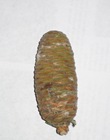 Tangent: Before we get to the cause, this is the first year I collected cones. When I found my first few up in Wyoming last month, I thought, “Great, I’ll add these to my collection.” (Yes, I have a pine cone collection, and it is impressive.) I brought it home and left it on a table. But within days it dried out and disintegrated into hundreds of flaky scales, leaving behind only a slender, woody “central axis.” Here’s a video of Awesome Wife shaking apart a dried-out Subalpine Fir cone.
Tangent: Before we get to the cause, this is the first year I collected cones. When I found my first few up in Wyoming last month, I thought, “Great, I’ll add these to my collection.” (Yes, I have a pine cone collection, and it is impressive.) I brought it home and left it on a table. But within days it dried out and disintegrated into hundreds of flaky scales, leaving behind only a slender, woody “central axis.” Here’s a video of Awesome Wife shaking apart a dried-out Subalpine Fir cone.
What’s going on is squirrels, specifically the North American Red Squirrel, Tamiasciurus husdonicus.
 Squirrels are true North American originals. Though they’re found today on every continent except Australia and Antarctica, the first squirrels appeared around 36 million years ago in North America. Since that time they’ve spread around the world as the continents bumped into each other, reaching Europe 30 million years ago, Africa 18 million years ago, and South America a mere 3 million years ago, as a result of the Great American Interchange (which we talked about back in August when we looked at the cool history of Cougars in North America.) In every new place they’ve reached, they’ve branched into dozens of new species, and today the Squirrel family, Sciurdae, includes around 280 species across 51 genera. Sciurdae is broken into 5 subfamilies, which I won’t detail, but the relationships between squirrels are interesting. Tree squirrels, or squirrels of the tribe Sciurini, which includes the Red Squirrel as well as the Gray Squirrels you see in parks, have been separate from Chipmunks and Ground Squirrels for at least 6 million years (around the same time we’ve been separate from Chimpanzees.) Chipmunks and Ground Squirrels (the most common examples here in Utah being the Uinta Chipmunk, Tamias umbrinus, and the Golden-Mantled Ground Squirrel, Spermophilus lateralis) are in turn much more closely-related to Marmots than they are to tree squirrels.
Squirrels are true North American originals. Though they’re found today on every continent except Australia and Antarctica, the first squirrels appeared around 36 million years ago in North America. Since that time they’ve spread around the world as the continents bumped into each other, reaching Europe 30 million years ago, Africa 18 million years ago, and South America a mere 3 million years ago, as a result of the Great American Interchange (which we talked about back in August when we looked at the cool history of Cougars in North America.) In every new place they’ve reached, they’ve branched into dozens of new species, and today the Squirrel family, Sciurdae, includes around 280 species across 51 genera. Sciurdae is broken into 5 subfamilies, which I won’t detail, but the relationships between squirrels are interesting. Tree squirrels, or squirrels of the tribe Sciurini, which includes the Red Squirrel as well as the Gray Squirrels you see in parks, have been separate from Chipmunks and Ground Squirrels for at least 6 million years (around the same time we’ve been separate from Chimpanzees.) Chipmunks and Ground Squirrels (the most common examples here in Utah being the Uinta Chipmunk, Tamias umbrinus, and the Golden-Mantled Ground Squirrel, Spermophilus lateralis) are in turn much more closely-related to Marmots than they are to tree squirrels.
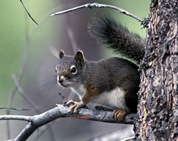 Unlike Gray Squirrels, Red Squirrels, which are also sometimes known as Pine Squirrels, don’t hang out in parks. The non-avian, agitated chattering or “chirping” you hear up in the trees of a Wasatch PLT forest is the Red Squirrel. Their 2 most common calls are a warning call and a mating call, which are supposedly very similar (and which I can’t tell apart. I assume the calls I hear are overwhelmingly warning calls.)
Unlike Gray Squirrels, Red Squirrels, which are also sometimes known as Pine Squirrels, don’t hang out in parks. The non-avian, agitated chattering or “chirping” you hear up in the trees of a Wasatch PLT forest is the Red Squirrel. Their 2 most common calls are a warning call and a mating call, which are supposedly very similar (and which I can’t tell apart. I assume the calls I hear are overwhelmingly warning calls.)
Red Squirrels usually breed once a year, in the late Spring/early Summer, giving birth to 3-5 pups. (Kits? Babies? Squittens? Don’t know what a baby squirrel is called…)
The favorite foods of Red Squirrels are nuts- especially PLT nuts. Extracting the nuts from the scales requires some jaw-work and firm footing, and is difficult to do in a tree. So the squirrels cut down the cones with their teeth, and then descend to the ground to collect or dismember the cones. If you find a Fir cone lying on the ground in the Wasatch, it’s almost always the recent work of a Red Squirrel who just cut it down, but has yet to “work” it.
 Sometimes you’ll find extensive piles of cones scales, like this pic (left) at the base of an old White Fir, where the squirrels have disassembled large numbers of Fir cones. The green-needled twigs are another giveaway; squirrels will often cut the upright cones from an inch or two below the base, sending a piece of attached twig to the ground as well. The “fresh” – looking Douglas Fir and Spruce cones are also squirrel-cut.
Sometimes you’ll find extensive piles of cones scales, like this pic (left) at the base of an old White Fir, where the squirrels have disassembled large numbers of Fir cones. The green-needled twigs are another giveaway; squirrels will often cut the upright cones from an inch or two below the base, sending a piece of attached twig to the ground as well. The “fresh” – looking Douglas Fir and Spruce cones are also squirrel-cut.
Squirrels don’t hibernate; a Red Squirrel burns over 12,000,000 calories staying alive through the winter. That equates to about 5,000 Douglas Fir or Engelman Spruce Cones it needs to stash each Fall.
Tangent: Interestingly, both cones- Douglas Fir and Engelman Spruce- pack about 2,500 total calories a piece, even though the Spruce cone packs an average of 180 seeds/cone vs. 45 for Douglas Fir.  But each Douglas Fir seed carries 57 calories, as opposed to only 15 for the tiny Engelman Spruce seeds.
But each Douglas Fir seed carries 57 calories, as opposed to only 15 for the tiny Engelman Spruce seeds.
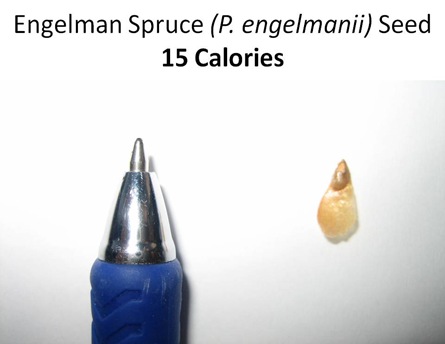 There are 2 really interesting things about Red Squirrels. First is their phylogeny (fancy science word for “Family Tree”), and second is the evolutionary “arms races” they’re engaged in with cone-bearing trees.
There are 2 really interesting things about Red Squirrels. First is their phylogeny (fancy science word for “Family Tree”), and second is the evolutionary “arms races” they’re engaged in with cone-bearing trees.
 For over a century there have been 3 recognized Red Squirrel species in North America. The Red Squirrel here in Utah, T. hudsonicus, ranges clear from Labrador to Tennessee to Arizona to Alaska. The Douglas Squirrel (pic left), T. douglasii, lives in the Sierra Nevada, Pacific Northwest and Northern California. And the third North American Red Squirrel, T. mearnsi, is limited solely to the high, forested mountains of Northern Baja California.
For over a century there have been 3 recognized Red Squirrel species in North America. The Red Squirrel here in Utah, T. hudsonicus, ranges clear from Labrador to Tennessee to Arizona to Alaska. The Douglas Squirrel (pic left), T. douglasii, lives in the Sierra Nevada, Pacific Northwest and Northern California. And the third North American Red Squirrel, T. mearnsi, is limited solely to the high, forested mountains of Northern Baja California.
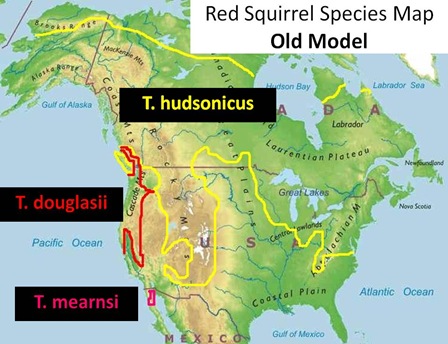 But genetic research over the last decade indicates that this traditional, long-accepted taxonomy is wrong. It now appears that the Red Squirrels in the highlands of Arizona and New Mexico are are the most genetically distinct of all, having long since been separated by dry, hot interglacial periods over the last couple hundred millennia. Red Squirrels throughout the rest of the continent appear more closely-related, with a clear- but more recent- separation between the Sierra Nevada/Northwest Red Squirrels, and those ranging from Utah to Quebec. As a result, modern researchers recommend the replacement of the 3 species taxonomy with just 1 species including 3 subspecies: a T. hudsonicus hudsonicus here in Utah and up to Alaska and over to the Atantic, a T. hudsonicus mogollonensis down in Arizona and New Mexico, and a T. hudsonicus douglasii from Vancouver down to Baja.
But genetic research over the last decade indicates that this traditional, long-accepted taxonomy is wrong. It now appears that the Red Squirrels in the highlands of Arizona and New Mexico are are the most genetically distinct of all, having long since been separated by dry, hot interglacial periods over the last couple hundred millennia. Red Squirrels throughout the rest of the continent appear more closely-related, with a clear- but more recent- separation between the Sierra Nevada/Northwest Red Squirrels, and those ranging from Utah to Quebec. As a result, modern researchers recommend the replacement of the 3 species taxonomy with just 1 species including 3 subspecies: a T. hudsonicus hudsonicus here in Utah and up to Alaska and over to the Atantic, a T. hudsonicus mogollonensis down in Arizona and New Mexico, and a T. hudsonicus douglasii from Vancouver down to Baja.  The former T. mearnsi appears to be a group of of T.h. douglasii that became “stranded” but desert within the last 11,000 years. The other, earlier subspecies divisions appear to have happened sometime between 80,000 and 240,000 years ago, roughly the same time when “native” Dandelions made it across Beringia.
The former T. mearnsi appears to be a group of of T.h. douglasii that became “stranded” but desert within the last 11,000 years. The other, earlier subspecies divisions appear to have happened sometime between 80,000 and 240,000 years ago, roughly the same time when “native” Dandelions made it across Beringia.
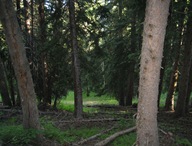 For years botanists have noticed that Spruce of many species (including P. engelmanii) have occasional “mast” years, in which they produces far more cones (and seeds) than usual. It’s thought that Spruce evolved the habit of mast years to produce far more seeds than a population of squirrels or other seed-predators could possibly consume/cache in a single year, ensuring that a large number of seeds would survive. By “masting” only occasionally, the Spruce forest ensures that the squirrel population remains low enough to be unable to eat/cache off the cones/seeds in a mast year. But Red Squirrels have come up with an evolutionary countermeasure; in mast years they give birth to not 1 but 2 litters of pups/Squittens(?), taking advantage of the surplus of food.
For years botanists have noticed that Spruce of many species (including P. engelmanii) have occasional “mast” years, in which they produces far more cones (and seeds) than usual. It’s thought that Spruce evolved the habit of mast years to produce far more seeds than a population of squirrels or other seed-predators could possibly consume/cache in a single year, ensuring that a large number of seeds would survive. By “masting” only occasionally, the Spruce forest ensures that the squirrel population remains low enough to be unable to eat/cache off the cones/seeds in a mast year. But Red Squirrels have come up with an evolutionary countermeasure; in mast years they give birth to not 1 but 2 litters of pups/Squittens(?), taking advantage of the surplus of food.
 The second arms race isn’t evident here in the Wasatch, but is just 50 miles East in the Uintas, where Lodgepole Pine grows, and there Red Squirrels prey upon Lodgepole seed cones as well. One of the big differences between T.h. hudsonicus here in Utah and T.h. douglasii over in California is that our Red Squirrels here have much stronger jaw muscles, which come in handy for tearing apart a pine cones with one’s teeth.
The second arms race isn’t evident here in the Wasatch, but is just 50 miles East in the Uintas, where Lodgepole Pine grows, and there Red Squirrels prey upon Lodgepole seed cones as well. One of the big differences between T.h. hudsonicus here in Utah and T.h. douglasii over in California is that our Red Squirrels here have much stronger jaw muscles, which come in handy for tearing apart a pine cones with one’s teeth.
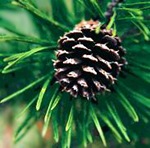 There’s also a difference between our Lodgepoles and those over in the Sierras. Rocky Mountain Lodgepole Pine grows closed “serotinous” cones (pic above right), whose scales only open under great heat, such as in a forest fire. But Sierra Lodgepoles bear cones with open scales (pic left), and it appears that the close Rocky Mountain Lodgepole cones have evolved through selection pressure from strong-jawed Red Squirrels, who in turn have evolved their stronger jaws through selection pressure from closed-cone Lodgepoles, who in turn… and so on.
There’s also a difference between our Lodgepoles and those over in the Sierras. Rocky Mountain Lodgepole Pine grows closed “serotinous” cones (pic above right), whose scales only open under great heat, such as in a forest fire. But Sierra Lodgepoles bear cones with open scales (pic left), and it appears that the close Rocky Mountain Lodgepole cones have evolved through selection pressure from strong-jawed Red Squirrels, who in turn have evolved their stronger jaws through selection pressure from closed-cone Lodgepoles, who in turn… and so on.
 Side Note: PLT cones- Spruce, Fir and Douglas Fir are always somewhat flimsy and papery compared to true pine cones, and Red Squirrels generally favor PLT seeds over Pine seeds as a result. The only other squirrel we’ve looked at, the Aberts Squirrel, Sciurus aberti, from when I lived back in Colorado, takes the opposite approach; its larger size and bigger, more muscular jaw enables it to focus its diet almost exclusively on the seeds and a few other parts of Ponderosa Pine. Hence its absence from the near pine-less Wasatch.
Side Note: PLT cones- Spruce, Fir and Douglas Fir are always somewhat flimsy and papery compared to true pine cones, and Red Squirrels generally favor PLT seeds over Pine seeds as a result. The only other squirrel we’ve looked at, the Aberts Squirrel, Sciurus aberti, from when I lived back in Colorado, takes the opposite approach; its larger size and bigger, more muscular jaw enables it to focus its diet almost exclusively on the seeds and a few other parts of Ponderosa Pine. Hence its absence from the near pine-less Wasatch.
When I’m out and about in the Wasatch it’s always interesting for me to listen to the squirrels chattering above me and think about the selection pressures and positive feedback loops that make them what they are. When I come home afterwards, it makes me think about what selection pressures and feedback loops made the big-brained hairless primates that live in my house.
Side Note: Many thanks to Brian Arbogast, Robert Browne and Peter Weigel, whose 2001 paper Evolutionary Genetics and Pleistocene Biogeography of North American Tree Squirrels provided the phylogenetic data used in this post. As always I am exceedingly grateful to researchers who are kind enough to make their research available on the web for “motivated laypeople” such as myself.
5 comments:
Thanks Jodie. I saw that when I was trying to figure it out and I thought: no way, "babies" is so lame. But I guess that's what they're called. I think we need a campaign to re-brand baby squirrels as "Squittens." Maybe we can come up with a line of Squitten dolls/toys/books (a la Webkinz) and get rich!
I've really enjoyed your last few, very reflective posts. Do you take requests on post topics? As you know there was a large fire in Draper during the summer. As I was running errands yesterday I noticed that the snow seemed to cling to the burned area more than where there were live trees. It seems that today the snow has stayed in that burned area but it's melted in the other areas. Is this all in my head? or is there something scientific going on? (Do you feel like Bill Nye? I kind of think of you as a very well rounded Bill Nye :)
Hey Kristin, here at WWTWWU we aim to please. Check out http://watchingtheworldwakeup.blogspot.com/2008/10/angles-part-1-freezing-melting-plants.html for the answer to your question (with graphics!)
Awesome post-- why don't you submit it to Berry Go Round, the plant blog carnival? I was hoping you'd get to CC Smith's T. hudsonicus stuff, which I loved back in grad school! Got dig co-evolution...
SLW- I didn't know there was a plant blog carnival. Now I do, and I just followed your suggestion and submitted. Thanks! -Alex
Post a Comment